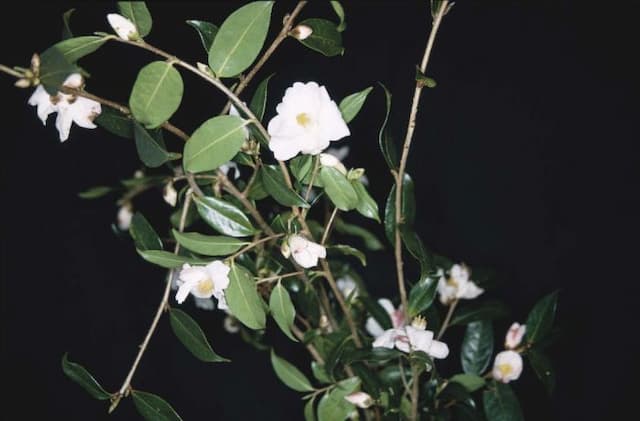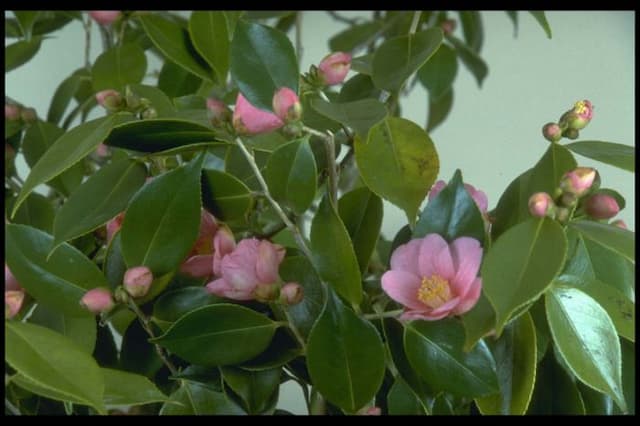Japanese camellia Camellia japonica 'Brushfield's Yellow'

ABOUT
Camellia japonica 'Brushfield's Yellow' is a flowering plant typically prized for its ornamental value. This variety of camellia is recognized by its lush, glossy, dark green leaves that provide a striking backdrop to its flowers. The blooms themselves are notable for their unique coloring and form: they exhibit a creamy-white exterior with petals arranged in an intricate, formal double pattern, resembling a rosette. At the center of the flower, there is a cluster of petaloids (small, petal-like structures) that are tinged with a light yellow hue, giving the plant its namesake 'Yellow'. This subtle hint of yellow contrasts gently with the creamy-white, adding a touch of warmth and depth to the overall appearance of the bloom. The flowers are quite large and showy, making them a standout feature in the garden during their blooming season. Camellia japonica 'Brushfield's Yellow' presents an elegant and classic appearance that makes it a favored choice for gardeners looking to add a touch of sophistication to their landscapes.
About this plant
 Names
NamesFamily
Theaceae.
Synonyms
Japanese Camellia, Camellia, Brushfield's Yellow.
Common names
Camellia japonica 'Brushfield's Yellow'
 Toxicity
ToxicityTo humans
Japanese camellia, including the 'Brushfield's Yellow' variety, is generally considered non-toxic to humans. Ingesting any part of the plant is unlikely to cause serious harm or poisoning.
To pets
Japanese camellia, specifically the 'Brushfield's Yellow' variety, is not known to be toxic to pets such as cats and dogs. Ingesting parts of this plant should not result in significant symptoms of poisoning, but as with any non-food plant, consuming large quantities might cause mild digestive upset.
 Characteristics
CharacteristicsLife cycle
Perennials
Foliage type
Evergreen
Color of leaves
Green
Flower color
Creamy yellow
Height
6-8 feet (1.8-2.4 meters)
Spread
6-8 feet (1.8-2.4 meters)
Plant type
Shrub
Hardiness zones
7
Native area
Japan
Benefits
 General Benefits
General Benefits- Aesthetic Appeal: Adds visual interest to gardens with its beautiful, semi-double creamy-yellow flowers that stand out against dark green foliage.
- Long Blooming Period: Offers a prolonged display of blossoms from late winter to early spring when few other plants are in flower.
- Hardiness: Camellia is known for being resilient and can tolerate cold temperatures in USDA zones 7-9, making it suitable for various climates.
- Low Maintenance: Requires minimal care once established, making it ideal for busy gardeners or those looking for low-effort landscaping options.
- Evergreen Foliage: Provides year-round interest with glossy, leathery leaves that keep their color even in the winter months.
- Wildlife Attraction: Attracts pollinators like bees when in bloom, contributing to the local ecosystem.
- Versatility in Landscaping: Can be used for various garden designs, including formal, cottage, and woodland settings.
- Privacy Screen: When planted in a row or as a hedge, it can provide privacy due to its dense foliage.
- Potential for Bonsai: Can be trained into a bonsai, offering an artistic and unique approach to gardening.
 Medical Properties
Medical PropertiesThis plant is not used for medical purposes.
 Air-purifying Qualities
Air-purifying QualitiesThis plant is not specifically known for air purifying qualities.
 Other Uses
Other Uses- Crafting Dyes: The petals of Camellia japonica can be used to create natural dyes for fabrics, offering subtle hues to textiles and artisan crafts.
- Photography Subjects: Camellia japonica 'Brushfield's Yellow', with its unique flowers, is often used by photographers looking for striking plant subjects to enhance their botanical portfolios.
- Wedding Decor: The blooms can be employed in wedding bouquets and decorations for their beauty and symbolism of love and longevity.
- Tea Garden Aesthetic: This plant can add an authentic look to tea gardens, as other camellias are used to produce traditional teas.
- Japanese Ikebana: The branches and blooms are suitable for use in Ikebana, the art of Japanese flower arranging, which emphasizes form, line, and harmony.
- Pressed Flower Art: The flowers can be pressed and used in creating delicate pressed flower art, often used in greeting cards and bookmarks.
- Botanical Illustration: Botanical artists may use Camellia japonica as a subject for detailed illustration work, capturing its distinctive form and color.
- Floral Water: Petals can be infused in water to create lightly scented floral waters for use in beauty and bath products.
- Lane Marking: Fallen petals can be whimsically used to mark paths or lanes for garden parties and outdoor events.
- Seedpod Art: After flowering, the interesting seedpods can be dried and used in decorative crafts or as natural art installations.
Interesting Facts
 Feng Shui
Feng ShuiThe Camellia is not used in Feng Shui practice.
 Zodiac Sign Compitability
Zodiac Sign CompitabilityThe Camellia is not used in astrology practice.
 Plant Symbolism
Plant Symbolism- Devotion and Loyalty: Often, Camellias symbolize devotion and loyalty, which can reflect the steadfast nature of love or deep friendship.
- Desire or Longing: In some cultures, Camellias represent a longing for someone and are given to express the desire to be with the loved one.
- Admiration: The Camellia's perfect, symmetrical form can indicate admiration for someone's beauty or perfection in character.
- Affection: Gifting Camellias can convey affection towards someone, showing warmth, and gentle thoughts.
- Refinement: The refined beauty of the Camellia blossom is often associated with the idea of refined beauty and perfection.
- Perseverance: In some narratives, the Camellia also stands in for perseverance due to its ability to bloom during the cold winter months.
 Water
WaterJapanese Camellia should be watered thoroughly when the top inch of soil feels dry to the touch, which typically means it may require watering approximately once a week, but this frequency can change depending on weather conditions and soil type. Apply water directly to the base of the plant, avoiding wetting the foliage to help prevent disease. Use enough water to moisten the soil to a depth of at least 8 inches; for a mature Japanese Camellia, this usually equates to around 2 gallons per watering session, though newly planted or potted specimens might need less. Do not allow the plant to sit in waterlogged soil, as camellias prefer well-draining conditions.
 Light
LightJapanese Camellia thrives in partial shade to light full sun. A spot that receives morning sunlight and afternoon shade is ideal, as this will protect the plant from the harsh afternoon sun. Avoid deep shade, as too little light can limit flowering and cause spindly growth, while extreme sun can lead to leaf scorch.
 Temperature
TemperatureJapanese Camellia prefers a temperature range between 60 to 80 degrees Fahrenheit for optimal growth. It can withstand minimum temperatures down to approximately 10 degrees Fahrenheit, but it's best to protect the plant from harsh, freezing conditions. Ensure the plant is positioned in a location that avoids cold, drying winds, particularly in the winter months.
 Pruning
PruningPrune the Japanese Camellia after it finishes blooming, typically in late winter or early spring, to shape the plant, remove dead or weak wood, and encourage vigorous growth and bloom. Make your cuts just above a set of leaves to promote bushier growth. Pruning can also be done to control size or to remove diseased or damaged branches, ensuring the plant remains healthy and aesthetically pleasing.
 Cleaning
CleaningAs needed
 Soil
SoilThe best soil mix for Japanese Camellia 'Brushfield's Yellow' is well-draining with plenty of organic matter, such as a blend of pine bark, peat, and coarse sand. The ideal soil pH for Camellias should be slightly acidic, ranging from 5.5 to 6.5.
 Repotting
RepottingJapanese Camellia 'Brushfield's Yellow' should be repotted every 2-3 years. This helps to replenish the nutrients in the soil and to accommodate the growing root system.
 Humidity & Misting
Humidity & MistingJapanese Camellia 'Brushfield's Yellow' thrives in moderate to high humidity levels. A humidity level of 50-80% is ideal for this plant.
 Suitable locations
Suitable locationsIndoor
Place in bright, indirect light, protect from drafts, and maintain humidity.
Outdoor
Plant in partial shade, sheltered from harsh sun and winds.
Hardiness zone
7-9 USDA
 Life cycle
Life cycleCamellia japonica 'Brushfield's Yellow', commonly known as Japanese camellia, begins its life as a seed that sprouts in a suitable environment with well-draining acidic soil and partial shade. The seedling stage involves the establishment of a root system and the emergence of the first true leaves, after which the plant enters a vegetative growth phase where it develops a woody stem, mature leaves, and branches, taking several years to mature. As it reaches maturity, typically between 5 to 7 years, it begins its reproductive stage, producing large, ornate, yellow-tinged white flowers primarily in late winter to spring. Following pollination, the flowers develop into dry seed capsules, which eventually open to release seeds, completing the reproductive cycle. The plant then enters a period of dormancy during colder months, conserving energy for the next growing season. With proper care, Camellia japonica can live for many decades, often outliving the people who plant them.
 Propogation
PropogationPropogation time
Late Winter-Early Spring
For Camellia japonica 'Brushfield's Yellow', commonly known as Yellow Camellia, semi-hardwood cuttings are the most popular method of propagation. This process is best done in late summer, when new growth has begun to mature and harden slightly. To propagate, one should take cuttings of about 4 to 6 inches in length with several leaves attached. The lower leaves should be removed, and the cut end dipped in rooting hormone to encourage root development. The cutting should then be planted in a well-drained potting mix, ideally in a pot that is approximately 4 inches in diameter (about 10 cm). The pot should be kept in a warm, humid environment with indirect light, and the soil kept moist but not waterlogged. Roots typically develop within a few months, after which the new Yellow Camellia can be gradually acclimatized to less protected conditions before eventual planting out.









